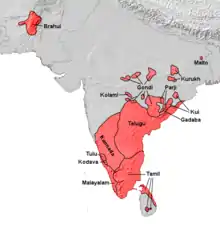Dravidian Nationalism
Dravidian nationalism, or Dravidianism, developed in Madras Presidency which comprises the four major ethno-linguistic groups in South India. This idea was popularized during the 1930s to 1950s by a series of small movements and organizations that contended that the South Indians (Dravidian people) formed a racial and a cultural entity that was different from the North Indians. Dravidianists have claimed that the Brahmins and other upper castes were originally Aryan migrants from the north, and that they imposed their language, Sanskrit, religion and heritage on the southern people.

| Articles related to |
| Dravidian politics |
|---|
| Part of a series on |
| Dravidian culture and history |
|---|
 |
| Portal:Dravidian civilizations |
History
The early Dravidian movement led by Periyar E. V. Ramasamy demanded an independent Dravidian State, which included all four Dravidian speaking states of South India.[1] The movement failed to find support among other Dravidian people and had to be limited to Tamil Nadu. A new morphed ideology of Dravidian nationalism gained momentum within Tamil Nadu during the 1930s and 1950s.
Dravidian Nationalism was thus based on three ideologies: dismantling of Brahmin hegemony; revitalization of the "Dravidian Languages" (that include Telugu, Kannada, Malayalam and Tamil) and social reform by abolition of existing caste systems, religious practices and recasting women's equal position in the society.
By the late 1960s, the political parties who were espousing Dravidian ideologies gained power within the state of Tamil Nadu.[2] Subsequently, the Nationalist ideologies lead to the argument by Dravidian leaders that, at minimum, Dravidians must have self-determination or, at maximum, secession from India.[3]
Dravidian nationalism has given rise to various doctrines of national mysticism and fanciful anachronism, such as Thaevanaeyap Paavaanar's Kumari Kandam, a continent spanning the Indian Ocean, submerged in 16,000 BC, or an "original Veda" composed by Mamuni Mayan some 10,000 years ago, Devaneya Pavanar's Homo Dravida of 200,000 BC, his Kumari Kandam civilization of 50,000 BC, his "Second Tamil Sangam" under a Pandyan king in 6097 BC, etc.
Political parties
Since the 1969 election victory of Dravida Munnetra Kazhagam (DMK) under C. N. Annadurai, Dravidian nationalism has been a permanent feature of the government of Tamil Nadu. After the Dravidian people achieved self-determination the claim for secession became weaker with most mainstream political parties, except a fringe few, are committed to development of Tamil Nadu within a united India. Most major Tamil Nadu regional parties such as DMK, All India Anna Dravida Munnetra Kazhagam (AIADMK) and Marumalarchi Dravida Munnetra Kazhagam (MDMK) frequently participate as coalition partners of other pan-Indian parties in the Union Government of India at New Delhi. The inability of the national parties of India to comprehend and capitalize on Dravidian nationalism is one of the main reasons for the lack of presence in Modern Tamil Nadu. The modern-day Dravidian Nationalism have actually contributed to a more flaccid celebration of Dravidian identity and the ‘uplift’ of the poor.[4]
Notes
- Indian Society and Social Institutions (2001), p. 541.
- Moorti 2004, p. 549
- Kohli 2004, pp. 285–299
- Palanithurai 1989